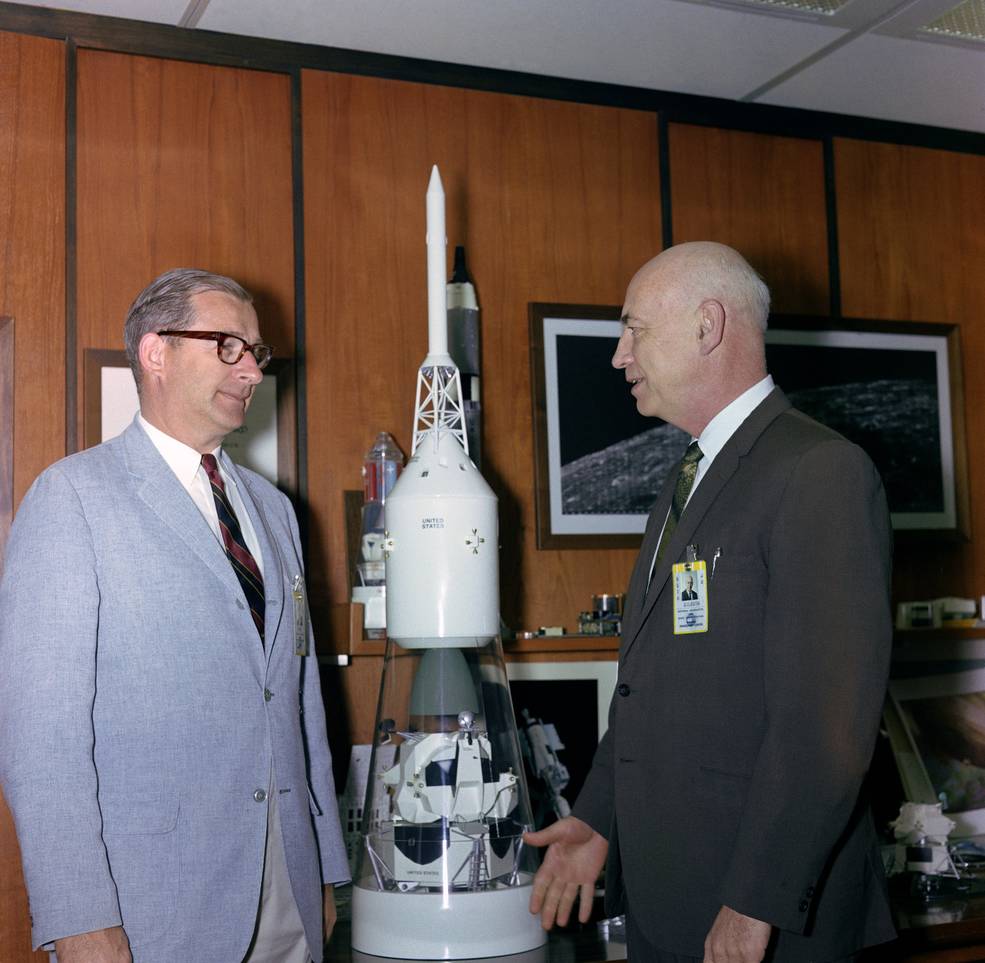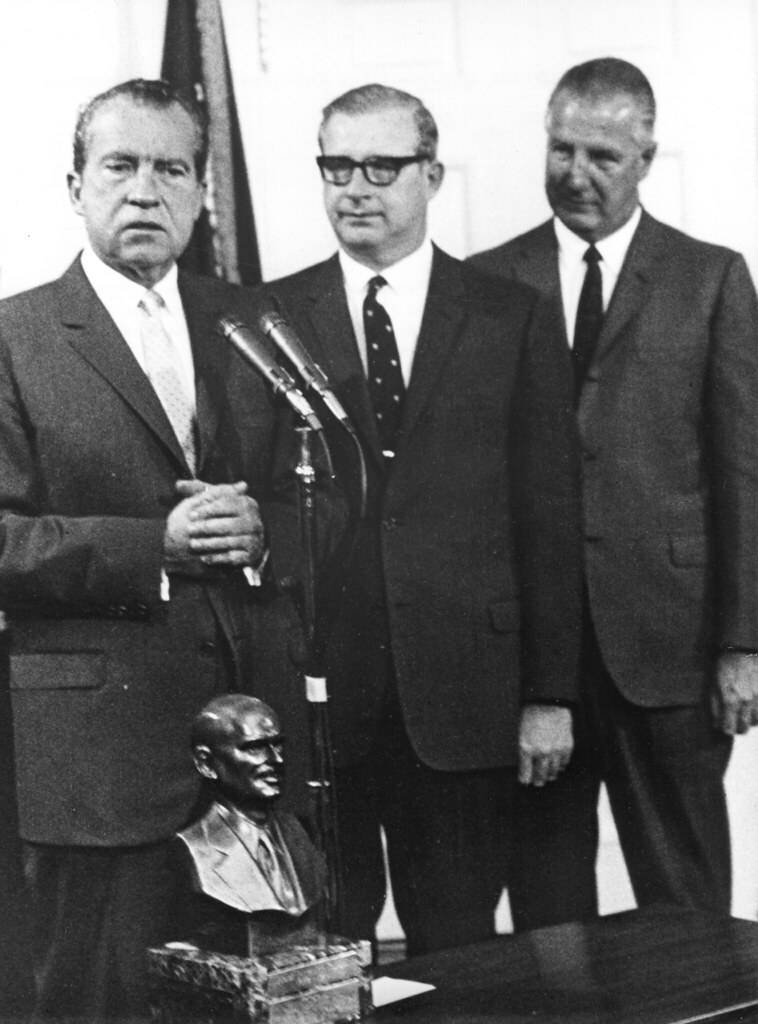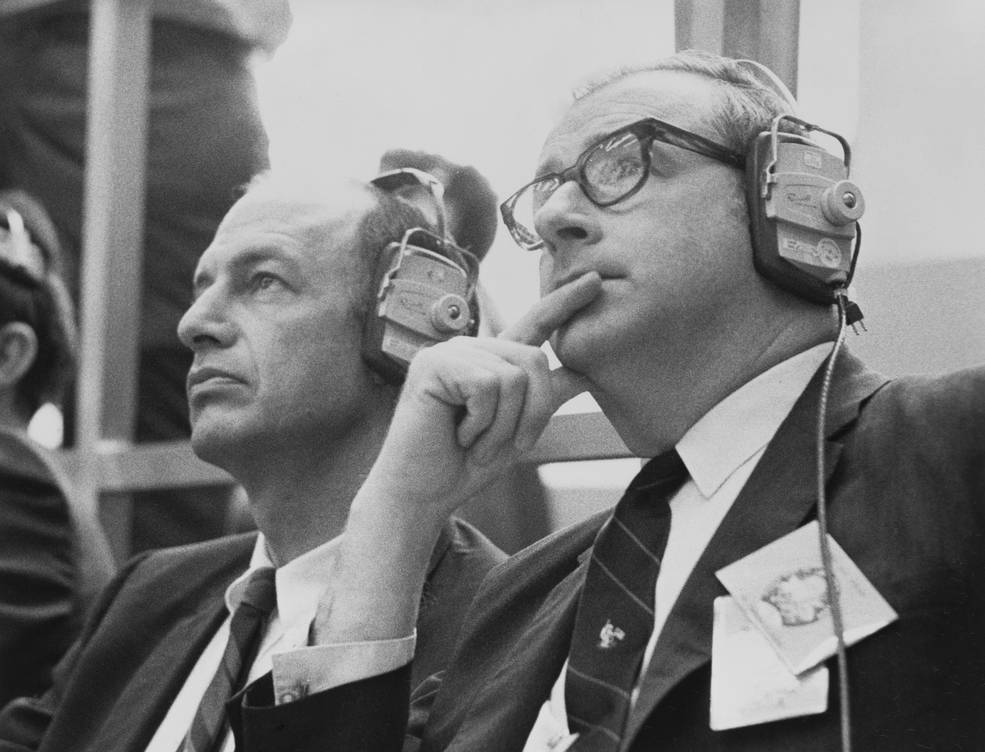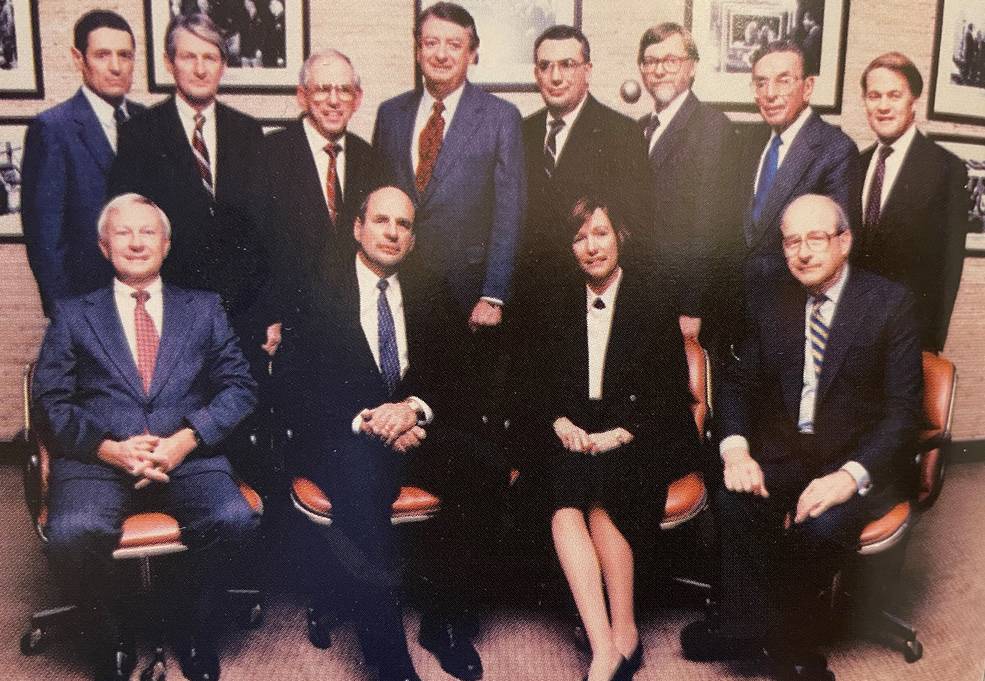On March 25, 1968, Thomas O. Paine was sworn in as NASA’s deputy administrator. Although he came to NASA with an extensive science, engineering, and management background, he had no prior experience working with the federal bureaucracy.
On March 25, 1968, Thomas O. Paine was sworn in as NASA’s deputy administrator. Although he came to NASA with an extensive science, engineering, and management background, he had no prior experience working with the federal bureaucracy. Joining NASA as it recovered from the tragic Apollo 1 fire and continued to work toward landing a man on the Moon by the end of decade, Paine led the agency, first as deputy administrator, then as acting administrator, and finally as NASA’s third administrator, through some its most historic times. He also faced significant challenges in the constrained budget environment following the Moon landing. He retired from NASA on Sept. 15, 1970, but remained active promoting his vision for a vibrant American space program.



Left: NASA Deputy Administrator Thomas O. Paine in his NASA Headquarters office. Middle: Paine, right, speaks with Wernher von Braun, director of NASA’s Marshall Space Flight Center in Huntsville, Alabama, and Saturn V rocket designer, in the Launch Control Center at NASA’s Kennedy Space Center in Florida during the Apollo 6 countdown. Right: Paine, left, meeting with Robert R. Gilruth, director of the Manned Spacecraft Center, now NASA’s Johnson Space Center in Houston, in April 1968.
The agency had been without a second-in-command since Robert C. Seamans resigned in October 1967, although he stayed on in a consultant role until his successor was named. Since the NASA deputy administrator position is a presidential appointment, Paine met with President Lyndon B. Johnson on Jan. 31, 1968. The President formally appointed Paine the next day, the Senate confirmed him the following week, and he was sworn in on March 25. Paine’s education – he received a bachelor’s degree in engineering from Brown University, and master’s and doctorate degrees in metallurgy from Stanford University – and nearly 20 years working at the General Electric Corporation, including as manager of its Center for Advanced Studies, served him well as NASA’s second-in-command. Administrator James E. Webb essentially put Paine in charge of NASA’s human spaceflight program. Paine worked to complete the reorganization of the agency following the January 1967 Apollo 1 fire in order to meet President John F. Kennedy’s goal of landing a man on the Moon before the end of the decade. Two weeks after taking office, Paine traveled to NASA’s Kennedy Space Center (KSC) in Florida to watch the launch of Apollo 6, the second uncrewed Saturn V mission. Later in April, he traveled to the Manned Spacecraft Center (MSC), now NASA’s Johnson Space Center in Houston, and toured its facilities. He visited all the other NASA field centers and reported back to Webb on their status.


Left: On Nov. 3, 1968, at the LBJ Ranch in Johnson City, Texas, Acting NASA Administrator Thomas O. Paine, seated at left, listens as President Lyndon B. Johnson reads the commendation on the Exceptional Service Medals awarded to the Apollo 7 crew, seated at right. Right: Paine, at microphone, introduces the Apollo 8 crew during a postflight
celebration in New York City on Jan. 10, 1969.
On March 31, 1968, President Johnson surprised the nation by announcing that he would not run for re-election. Administrator Webb, a close ally of Johnson, did not want to remain in office after the inauguration of a new President in January 1969. Webb began turning over more responsibilities to Paine before announcing his resignation effective Oct. 7. Paine assumed the role of acting administrator just four days before Apollo 7 lifted off on the first crewed Apollo mission, a significant step toward achieving a Moon landing. The successful completion of the 11-day Apollo 7 mission that tested the Command and Service Modules – extensively redesigned after the fire – in Earth orbit enabled senior NASA managers and ultimately Paine to approve the plan to send Apollo 8 on its daring and historic Christmas-time lunar orbit mission.



Left: President Richard M. Nixon, left, introduces Thomas O. Paine, center, as his choice for NASA administrator, as Vice President Spiro T. Agnew looks on. Middle: Paine, right, enjoys the success of the Apollo 10 splashdown with Robert R. Gilruth, director of the Manned Spacecraft Center, now NASA’s Johnson Space Center in Houston. Right: Paine, right, with Apollo 8 astronaut William A. Anders and Vice President Agnew in the Launch Control Center at NASA’s Kennedy Space Center in Florida, await the launch of Apollo 11.
Shortly after taking office, President Richard M. Nixon asked Paine to stay on as NASA Administrator. On March 5, 1969, as Apollo 9 circled the Earth on the first crewed test of the Lunar Module (LM), Nixon and Vice President Spiro T. Agnew introduced Paine in a brief White House ceremony. The Senate confirmed him on March 20 and Vice President Agnew swore him in as NASA’s third administrator on April 3. By that time, Apollo 9 had proven the flightworthiness of the LM, and in May, Apollo 10 completed a dress rehearsal for the Moon landing, with the LM approaching to within 9 miles of the lunar surface. On July 16, Paine watched from KSC’s Launch Control Center as Apollo 11 lifted off on its historic journey to fulfill President Kennedy’s goal.



Left: NASA Administrator Thomas O. Paine, left, and President Richard M. Nixon await the splashdown of Apollo 11 aboard the U.S.S. Hornet. Middle: Paine, second from right, and other senior NASA managers hold the first box of Moon rocks after its arrival at Ellington Air Force Base in Houston. Right: Paine, in the passenger seat, rides with the Apollo 11 crew in the ticker tape parade in New York City.
Credit: Image courtesy NYC Municipal Archives.
On July 20, Paine watched from the MSC’s Mission Control Center as Apollo 11 astronauts Neil A. Armstrong and Edwin E. “Buzz” Aldrin took humanity’s first steps on the Moon. Two days later, he found himself aboard Air Force One with President Nixon who, after the successful Moon landing, had decided to welcome the astronauts home on the prime recovery ship U.S.S. Hornet, stationed in the Pacific Ocean. A day after the July 24 splashdown, Paine posed with other senior NASA managers at Ellington Air Force Base near MSC in Houston with the first container of Moon rocks airlifted from the Hornet. Following the Apollo 11 astronauts’ three-week quarantine, Paine accompanied them on their whirlwind day-long celebratory tours of New York, Chicago, and Los Angeles. President Nixon sent not only the astronauts on their global Giantstep goodwill tour, he also sent Paine on goodwill visits as well, both in the United States and internationally.



Left: Meeting at the White House on Sept. 15, 1969, to present the Space Task Group report to President Richard M. Nixon. Credit: Image courtesy Richard Nixon Presidential Library and Museum. Middle: NASA Administrator, right, shields the President and First Lady Pat Nixon from the rain with his umbrella as they await the launch of Apollo 12 at NASA’s Kennedy Space Center in Florida. Right: Paine, right, swears in George M. Low as NASA deputy administrator.
With the Moon landing now achieved, what was next? Even before the success of Apollo 11, President Nixon believed the nation needed a post-Apollo human spaceflight plan. On Feb. 13, 1969, he directed Vice President Agnew, as Chair of the National Aeronautics and Space Council, to organize a Space Task Group (STG) to report on options for the future directions of America’s space program. As a member of the STG, Paine sought to develop a long-term and expansive vision for America’s future in space. On Sept. 15, 1969, and still bathing in the afterglow of the successful Moon landing, the group presented its report to President Nixon in a meeting at the White House. They recommended three options, the most expansive of which would have doubled NASA’s annual budget by 1980 and included plans for a 50-person Earth-orbiting space station, a smaller station in lunar orbit, a lunar base, and a human mission to Mars in the 1980s. The other two options outlined more modest proposals with commensurably more modest costs. Faced with competing challenges to the federal budget, President Nixon chose not to act on the STG’s proposals. In January 1972, he approved the space shuttle, the only element remaining from the group’s more modest proposals. Meanwhile, President Nixon chose former Apollo Spacecraft Program Manager George M. Low, who originally crafted the plan to send Apollo 8 to the Moon, as the new NASA deputy administrator, with Paine swearing him into office on Dec. 3, 1969.




Left: NASA Administrator Thomas O. Paine, right, with Deputy Administrator George M. Low, in the Launch Control Center at NASA’s Kennedy Space Center in Florida, awaiting the Apollo 13 launch. Middle left: Paine, center, in the Mission Control Center at the Manned Spacecraft Center (MSC), now NASA’s Johnson Space Center in Houston, following the successful splashdown of Apollo 13. Middle right: Paine, at podium, introduces MSC Director Robert R. Gilruth, standing at far left, during the awarding of the Presidential Medal of Freedom to the Apollo 13 Mission Operations Team. Right: Paine, second from left, welcomes home the Apollo 13 astronauts in Honolulu, with President Richard M. Nixon.
During this time, the Apollo program continued, with successes and challenges. Apollo 12 performed a precision touchdown in November 1969 to visit the Surveyor 3 robotic spacecraft that had landed more than three years earlier. The third attempt at a landing, Apollo 13, nearly ended in disaster when an explosion crippled the spacecraft, and the astronauts returned to Earth safely thanks to the heroic efforts of the mission operations team. The accident and subsequent investigation resulted in a temporary hiatus of Moon landing missions. Budget realities resulted in the cancellation of first one – Apollo 20 in January 1970 – and later two more – Apollo 15 and 19 in September 1970 – planned Moon landing missions. Amid these disappointments, work on Skylab, a planned experimental space station that Paine had approved in October 1968 while acting administrator, proceeded toward an eventual May 1973 launch, and initial overtures toward cooperation in space with the Soviet Union seemed to bear fruit, eventually leading to the Apollo-Soyuz Test Project in July 1975. But Paine realized his grand vision for a robust human spaceflight program could not compete with overall budget realities. On July 28, 1970, barely a year after the first Moon landing, Paine announced to his staff that he planned to resign as NASA’s third administrator effective Sept. 15. He returned to the General Electric Corporation, as a vice president. In 1976, he left GE to serve as president and chief operating officer of the Northrup Corporation, retiring in 1982.


Left: Former NASA Administrator and chair of the National Commission on Space Thomas O. Paine, center, hands President Ronald W. Reagan a copy of the commission’s report “Pioneering the Space Frontier,” as Vice Chair Laurel L. Wilkening looks on. Right: The cover page of “Pioneering the Space Frontier,” also known as the Paine report.
Following President Ronald W. Reagan’s 1984 direction to NASA to build a space station, he established the National Commission on Space to formulate a long-term plan for the nation’s space program. He asked Paine to chair the commission that included 14 other luminaries of American aerospace and academia. Paine presented the commission’s consensus report, “Pioneering the Space Frontier: An Exciting Vision of Our Next Fifty Years in Space,” that charted plans for the U.S. space program into the 21st century, to President Reagan on July 22, 1986. While the report’s expansive plans included specific plans and timetables, those did not match budgetary realities. Its release only six months after the Challenger accident caused it to receive less than adequate attention.


Left: Former NASA Administrator Thomas O. Paine, seated at right, a member of the Advisory Committee on the Future of the U.S. Space Program, chaired by Norman R. Augustine, seated second from left. Right: Cover page of Committee’s 1990 report.
When President George H.W. Bush announced his Space Exploration Initiative (SEI) on July 20, 1989, one of its elements included the reestablishment of the National Space Council (NSC), as recommended in the Pioneering the Space Frontier report. He appointed Vice President J. Danforth “Dan” Quayle to lead the NSC. To plan the direction of the SEI, President Bush appointed Norman R. Augustine, chairman and CEO of Martin Marietta, to lead the twelve-member Advisory Committee on the Future of the U.S. Space Program, who in turn appointed Paine as one of the members. By the time the committee presented its report on Dec. 10, 1990, much of Paine’s ambitious plans, such as human Mars exploration, had been removed by consensus of the other members. The report, and the SEI it was designed to buttress, did not gain much traction.
Paine died of cancer in Los Angeles on May 4, 1992, at the age of 70. One of Paine’s often overlooked post-NASA accomplishments involved securing a piece of an Apollo 11 Moon rock for inclusion in one of the stained-glass windows in the National Cathedral in Washington, D.C.


























